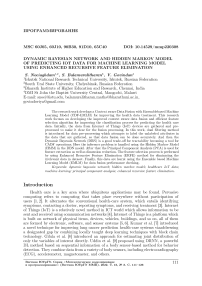Dynamic Bayesian network and hidden Markov model of predicting IoT data for machine learning model using enhanced recursive feature elimination
Автор: Noeiaghdam S., Balamuralitharan S., Govindan V.
Рубрика: Программирование
Статья в выпуске: 3 т.15, 2022 года.
Бесплатный доступ
The research work develops a Context aware Data Fusion with Ensemblebased Machine Learning Model (CDF-EMLM) for improving the health data treatment. This research work focuses on developing the improved context aware data fusion and efficient feature selection algorithm for improving the classification process for predicting the health care data. Initially, the data from Internet of Things (IoT) devices are gathered and pre-processed to make it clear for the fusion processing. In this work, dual filtering method is introduced for data pre-processing which attempts to label the unlabeled attributes in the data that are gathered, so that data fusion can be done accurately. And then the Dynamic Bayesain Network (DBN) is a good trade-off for tractability becoming a tool for CADF operations. Here the inference problem is handled using the Hidden Markov Model (HMM) in the DBN model. After that the Principal Component Analysis (PCA) is used for feature extraction as well as dimension reduction. The feature selection process is performed by using Enhanced Recursive Feature Elimination (ERFE) method for eliminating the irrelevant data in dataset. Finally, this data are learnt using the Ensemble based Machine Learning Model (EMLM) for data fusion performance checking.
Dynamic bayesain network, hidden markov model, healthcare iot data, machine learning, principal component analysis, enhanced recursive feature elimination
Короткий адрес: https://sciup.org/147238545
IDR: 147238545 | УДК: 519.217 | DOI: 10.14529/mmp220308
Список литературы Dynamic Bayesian network and hidden Markov model of predicting IoT data for machine learning model using enhanced recursive feature elimination
- Hao Jin, Yan Luo, Peilong Li, Jomol Mathew. A Review of Secure and Privacy-Preserving Medical Data Sharing. IEEE Access, 2019, vol. 7, pp. 61656-61669. DOI: 10.1109/ACCESS.2019.2916503
- Perez S., Hernandez-Ramos J.L., Pedone D., Rotondi D., Straniero L. et al. A Digital Envelope Approach Using Attribute-Based Encryption for Secure Data Exchange in IoT Scenarios. Global Internet of Things Summit, 2017, pp. 1-6. DOI: 10.1109/GI0TS.2017.8016281
- Mohanta B.K., Jena D., Sobhanayak S. Multi-Party Computation Review for Secure Data Processing in IoT-Fog Computing Environment. International Journal of Security and Networks, 2020, vol. 15, no. 3, pp. 164-174. DOI: 10.1504/IJSN.2020.109697
- Xueping Liang, Juan Zhao, Sachin Shetty, Jihong Liu, Danyi Li. Integrating Blockchain for Data Sharing and Collaboration in Mobile Healthcare Applications. IEEE 28th Annual International Symposium on Personal, Indoor, and Mobile Radio Communications, Montreal, 2017, pp. 1-5. DOI: 10.1109/PIMRC.2017.8292361
- Theodouli A., Arakliotis S., Moschou K., Votis K., Tzovaras D. On the Design of a Blockchain-Based System to Facilitate Healthcare Data Sharing. 17th IEEE International Conference on Trust, Security and Privacy in Computing and Communications/12th IEEE International Conference on Big Data Science and Engineering, New York, 2018, pp. 1374-1379. DOI: 10.1109/TrustCom/BigDataSE.2018.00190
- Mikula T., Jacobsen R.H. Identity and Access Management with Blockchain in Electronic Healthcare Records. 21st Euromicro Conference on Digital System Design, Prague, 2018, pp. 699-706. DOI: 10.1109/DSD.2018.00008
- Rajesh Kumar, WenYong Wang, Jay Kumar, Ting Yang, Abdullah Khan, Wazir Ali, Ikram Ali. An Integration of Blockchain and AI for Secure Data Sharing and Detection of CT Images for the Hospitals. Computerized Medical Imaging and Graphics, 2021, vol. 87, no. 1, article ID: 101812. DOI: 10.1016/j.compmedimag.2020.101812
- Gilula Z., McCulloch R.E., Rossi P.E. A Direct Approach to Data Fusion. Journal of Marketing Research, 2006, vol. 43, no. 1, pp. 73-83. DOI: 10.1509/jmkr.43.1.73
- Uddin M.Z., Hassan M.M., Alsanad A., Savaglio C. A Body Sensor Data Fusion and Deep Recurrent Neural Network-Based Behavior Recognition Approach for Robust Healthcare. Information Fusion, 2020, vol. 55, no. 3, pp. 105-115. DOI: 10.1016/j.inffus.2019.08.004
- Dautov R., Distefano S., Buyya R. Hierarchical Data Fusion for Smart Healthcare. Journal of Big Data, 2019, vol. 6, no. 1, pp. 1-23. DOI: 10.1186/s40537-019-0183-6
- Begum S., Barua S., Ahmed M.U. Physiological Sensor Signals Classification for Healthcare Using Sensor Data Fusion and Case-Based Reasoning. Sensors, 2014, vol. 14, no. 7, pp. 11770-11785. DOI: 10.3390/s140711770
- Muzammal M., Talat R., Sodhro A.H., Pirbhulal S. A Multi-Sensor Data Fusion Enabled Ensemble Approach for Medical Data from Body Sensor Networks. Information Fusion, 2020, vol. 53, no. 1, pp. 155-164. DOI: 10.1016/j.inffus.2019.06.021
- Ando B., Baglio S., Lombardo C.O., Marietta V. A Multisensor Data-Fusion Approach for ADL and Fall Classification. IEEE Transactions on Instrumentation and Measurement, 2016, vol. 65, no. 9, pp. 1960-1967. DOI: 10.1109/TIM.2016.2552678
- Sun-Chong Wang. Artificial Neural Network. Inter-disciplinary Computing in Java Programming, Springer, Boston, 2003, pp. 81-100. DOI: 10.1007/978-1-4615-0377-4_5
- Kondratenko Y.P., Klymenko L.P., Al Zu'bi E.Y.M. Structural Optimization of Fuzzy Systems' Rules Base and Aggregation Models, Kybernetes, 2013.
- Chen T., He T., Benesty M., Khotilovich V., Tang Y., Cho H. Xgboost: Extreme Gradient Boosting. R Package Version, 2015, vol. 1, no. 4, pp. 1-4.
- Chao-Ying Joanne Peng, Kuk Lida Lee, Ingersoll G.M. An Introduction to Logistic Regression Analysis and Reporting. The Journal of Educational Research, 2002, vol. 96, no. 1, pp. 3-14. DOI: 10.1080/00220670209598786


